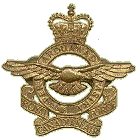AS YOU WERE . . .
WAR YEARS ECLECTICA
JOIN OUR FACEBOOK GROUP HERE
December 2014 Edition
Colourized Air Force Photos from the Colourizing
History FB site
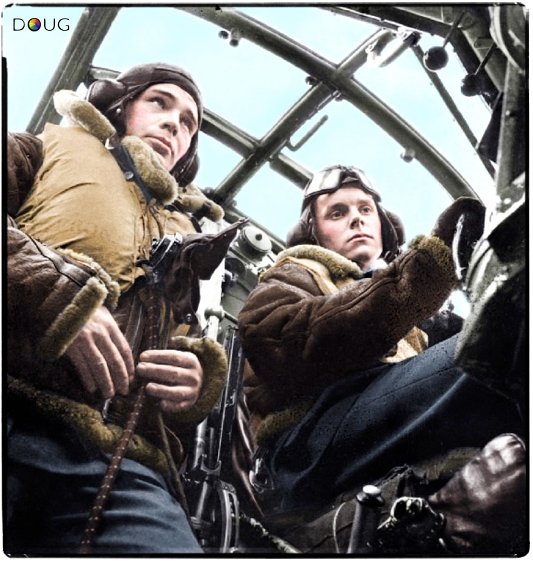
Colourized Air Force Photos from the Colourizing
History FB site

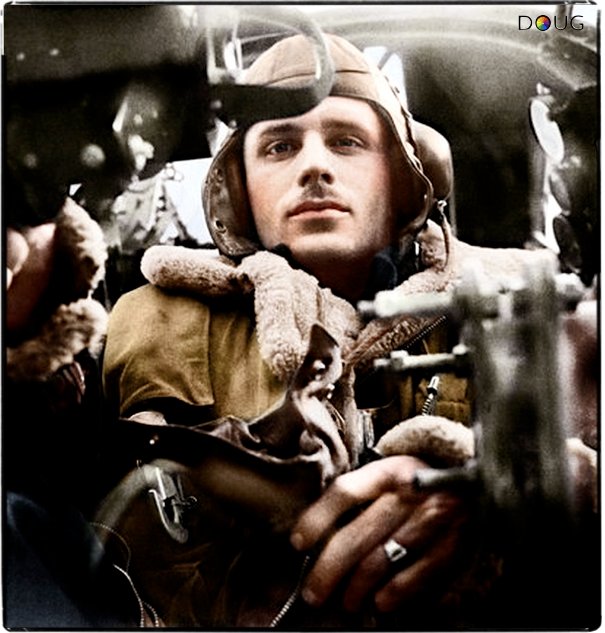
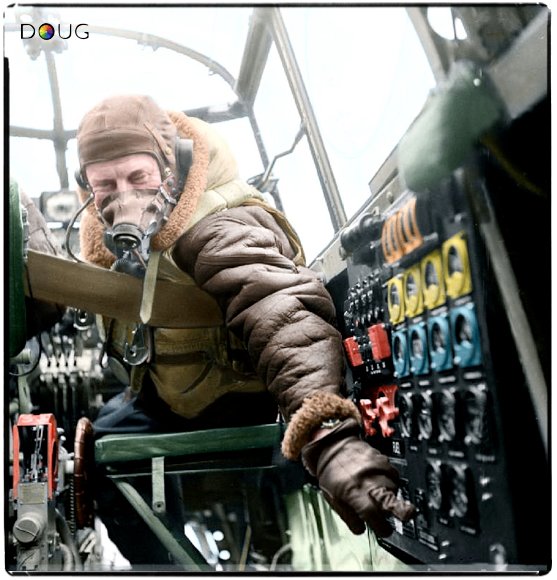
Flying Officer J B Burnside, the flight engineer on board an Avro
Lancaster B Mark III of No. 619 Squadron RAF based at Coningsby, Lincolnshire,
checks settings on the control panel from his seat in the cockpit.
February 1944 (IWM CH 12289)
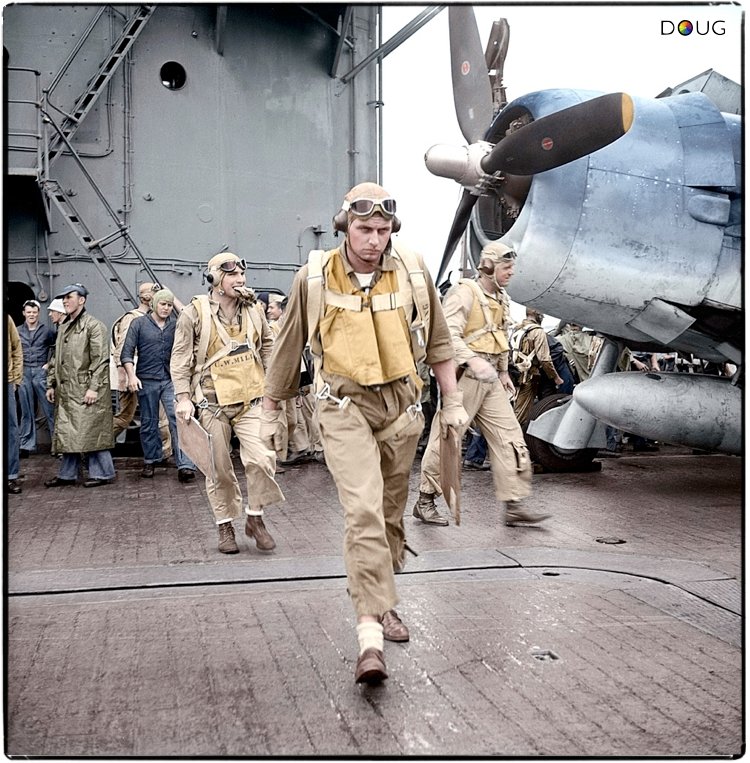
US Navy pilots, (in front) Lieutenant (jg) Henry H. Dearing of Cleveland,
Ohio, Ensign Charles W. Miller of Houston, Texas and Lieutenant (jg) Bus
Alder of San Mateo, California walking toward their Grumman F6F-3 'Hellcats'
aboard the aircraft carrier USS Saratoga (CV-3) 1943.11.05 (photo by Lt.
Wayne Miller of the U.S. Navy Combat Photo Unit)
These men provided fighter coverage for Avenger torpedo bombers
and Dauntless dive bombers.
On Nov 5, 1943, in response to reports of Japanese cruisers concentrating
at Rabaul, Papua New Guinea, the Saratoga aircraft penetrated the heavily
defended port and disabled most of the Japanese cruisers, ending the surface
threat to Bougainville. Saratoga herself escaped unscathed.
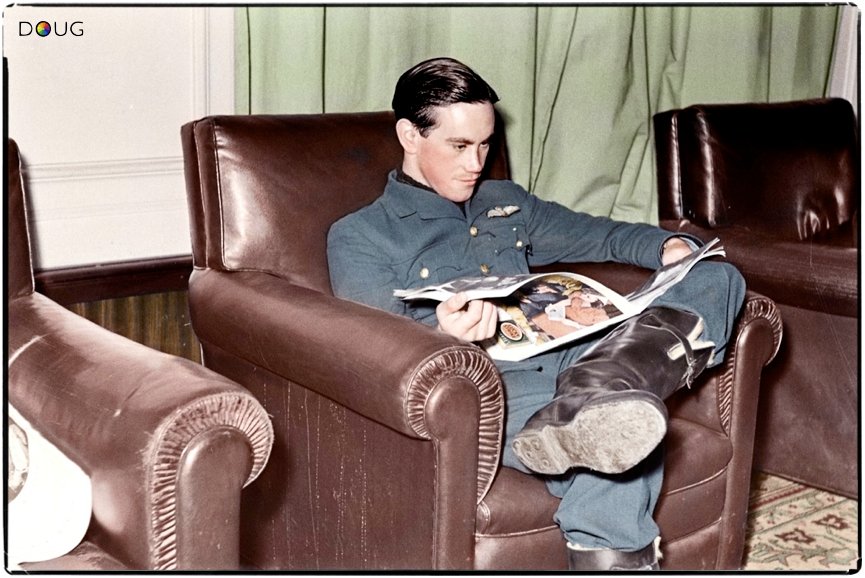
20-year-old Flying Officer Harold 'Birdie' Bird-Wilson, Nº17
Squadron RAF Debden. June/July 1940. This photo was featured in the Time
Life magazine in March 1941.
In September 1938 he survived an aerial accident but was badly burned
and lost his nose.
He underwent plastic surgery at the Queen Victoria Hospital, East
Grinstead
and was one of the earliest aircrew ‘guinea pig’ patients of the
famous, pioneering plastic surgeon, Sir Archibald McIndoe.
For some months ‘Birdie’ walked around without a nose whilst McIndoe
rebuilt it for him;
he subsequently became the No 2 member of the famous ‘Guinea Pig
Club’.
During the 'Battle of Britain' he was shot down by Luftwaffe ace
Adolf Galland on the 24th September 1940 in a dog fight over the River
Thames but baled out and was picked up by a riverboat. (Galland's 40th
victim)
Wounded with shrapnel from the guns of Galland’s Bf.109 embedded
in his body and suffering from burns for the second time in his flying
career, he recovered and returned to duty after two months recuperation.
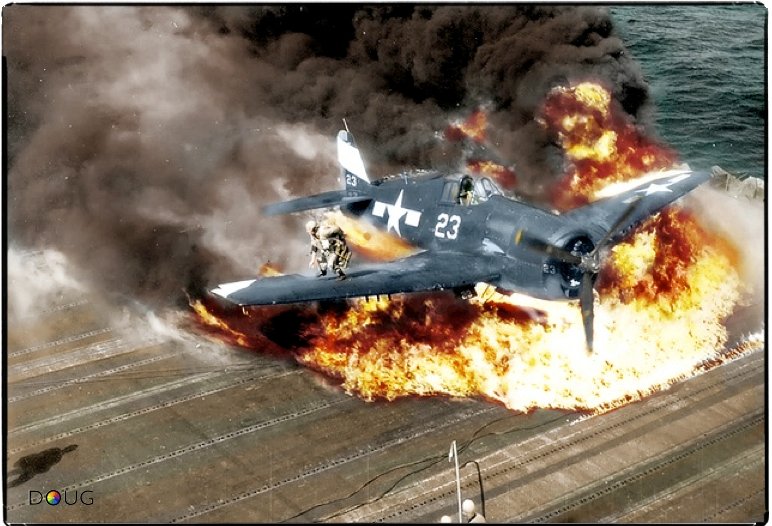
US. Ensign Ardon R. Ives escaping from his burning Grumman F6F-5
'Hellcat' of VF-9 fighter carrier group.
His fighter burst into flames when it hit a barrier and other planes
while landing on the USS Lexington (CV-16) on the 25th February 1945.
Ardon Ives was KIA in a dogfight with Japanese fighters just a few
months later on the 22nd May 1945, aged 23. He is buried in his home town
of Rockford, Kent County, Michigan.
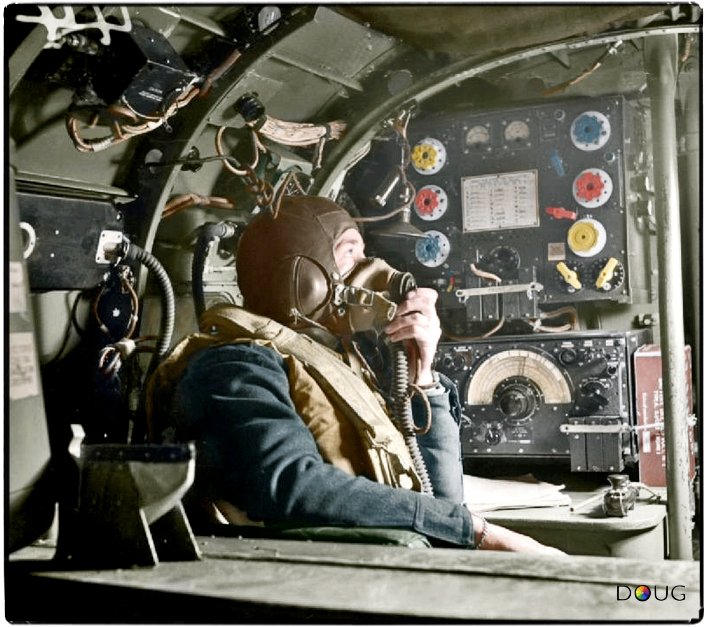
Flying Officer R W Stewart, a wireless operator on board an Avro
Lancaster B Mark I of No. 57 Squadron RAF based at Scampton, Lincolnshire,
speaking to the pilot from his position in front of the Marconi TR 1154/55
transmitter/receiver set. 1942-43 (IWM CH8790)
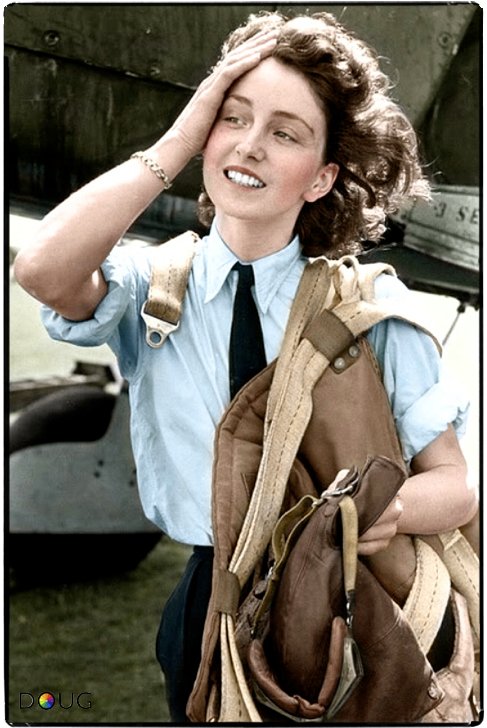
Maureen Dunlop (aged 24), an Air Transport Auxiliary (ATA) pilot,
in front of a Fairey Barracuda dive bomber, featured on the front cover
of the 'Picture Post' magazine 16th September 1944.
Born in Argentina of Australian/English parents, she joined the
ATA in 1942, trained to fly 38 types of aircraft, her 800 hours subsequently
logged included time in Spitfires, Mustangs, Typhoons, and bomber types
including the Wellington. She later stated that her favourite type to fly
was the de Havilland Mosquito. Initially attached to No.6 Ferry Pool at
RAF Ratcliffe near Leicester, she then moved to the all-female Ferry Pool
at Hamble, Southampton, which exclusively delivered Spitfires from Supermarine's
new factory at RAF Southampton. She was forced into occasional emergency
landings, once after the cockpit canopy of her Spitfire blew off after
take off and another occasion put down in a field after the engine of her
Fairchild Argus failed in the air. One in 10 women pilots died flying for
the ATA.
Maureen died on the 29th May 2012 aged 91.
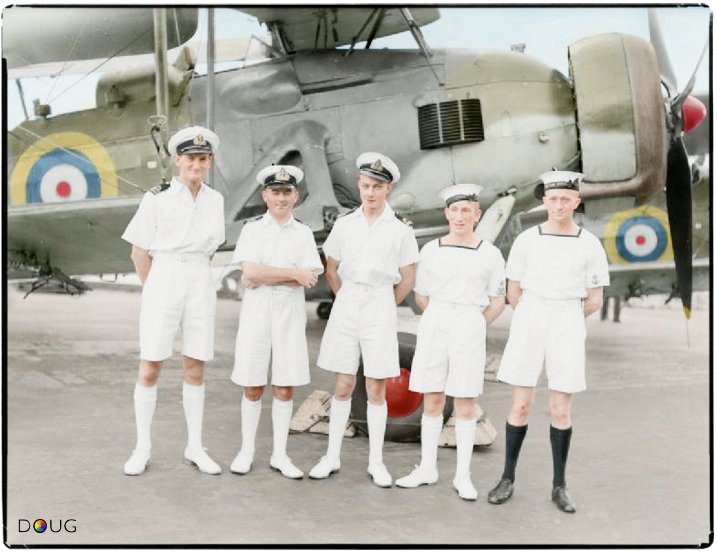
Admiral Somerville visited HMS Ark Royal to congratulate the officers
and ship's company after the successful engagement with the BISMARCK, October
1941.
Officers and ratings who were decorated for the part they played
in the sinking of the BISMARCK (on 24th May 1941), in front of a Fairey
('Stringbag') Swordfish aircraft.
Left to right: Lieutenant P D Gick, RN, awarded DSC; Lieutenant
Commander Eugene Esmonde, RN, awarded DSO; Sub Lieutenant V K Norfolk,
RN, awarded DSC; A/PO Air L D Sayer awarded DSM; A/Ldg Air A L Johnson,
awarded DSM. all from 825 Squadron, HMS Victorious.
Some nine months later on 12th February 1942, Esmonde and Johnson
would both die attempting to stop the battleships Scharnhorst and Gneisenau
and the heavy cruiser Prinz Eugen from making the 'Channel Dash'.
Norfolk was KIA over Cherbourg 17/9/42. Both Gick and Sayer survived
the war.
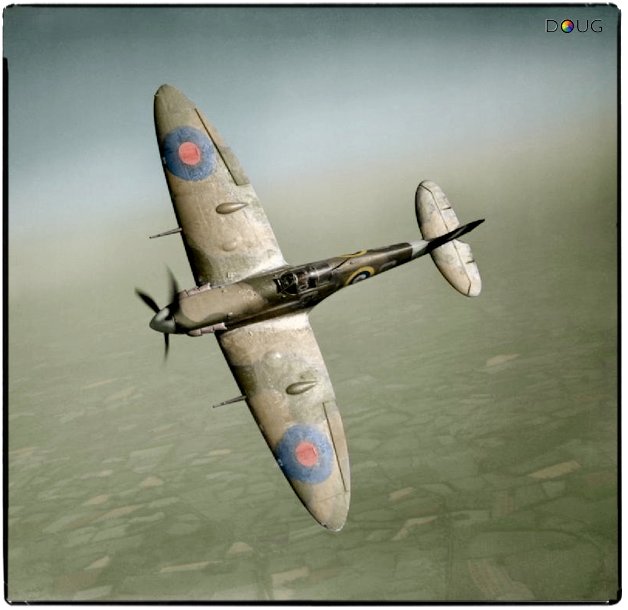
Supermarine Spitfire Mk VB (R6923, QJ-S) of Nº92 (East India)
Squadron RAF based at Biggin Hill, Kent, UK. Flown here by Fl.Off. Alan
Wright on 19th May 1941.
On the afternoon of the 21st June '41 it was flown by Sgt. G.W.Aston
on a bomber escort run over France and shot down a Bf 109 before it too
got hit and had to ditch in the sea. Sgt. Aston survived and returned for
duty that same evening.
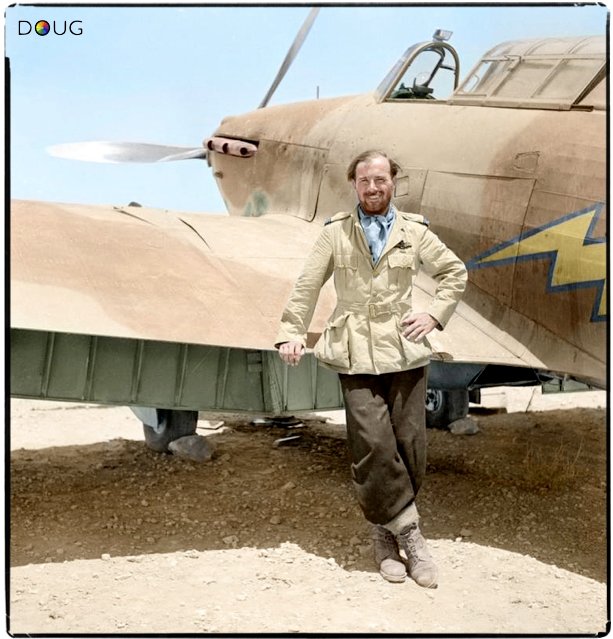
Fl.Lt. Dudley S.G. Honor, Nº 274 Squadron RAF poses by a Hawker
Hurricane of the squadron at Gerawala, Egypt, on rejoining his unit following
his rescue.
On the afternoon of 25th May 1941, his Mk.I Hurricane (W9266) and
that of Fl.Lt Hugh Down were attacking the aerodrome at Maleme, Crete.
Down's plane was hit but Honor shot down an Italian SM79 and a German JU52
before being attacked by a Bf 110 and then a Bf 109. His plane crashed
into the sea, sinking some forty feet, but because he was wearing a German
self inflatable life jacket, he was able to reach the surface. After a
four hour swim he managed to drag himself onto the rocks. He was found
by Cretan peasants and a party of Greek soldiers and after six days in
hiding was rescued by a passing RAF Sunderland that saw him signalling
from his pocket torch. The Sunderland pilot said it was a million to one
chance that he was spotted, they were looking for Major General Weston
and his staff, with Honor giving directions down the coast, they located
the General at Sfakia on about the 31st May.
Group Captain Honor died on December 26th 2007. © IWM (CM 941)
( The Hurricane is showing a Yellow lightning flash of the 247 Squadron
and the front underside of the nose and leading edges sport an Italian
camouflage, supposed to confuse Italian ground AA gun crews in North Africa.)
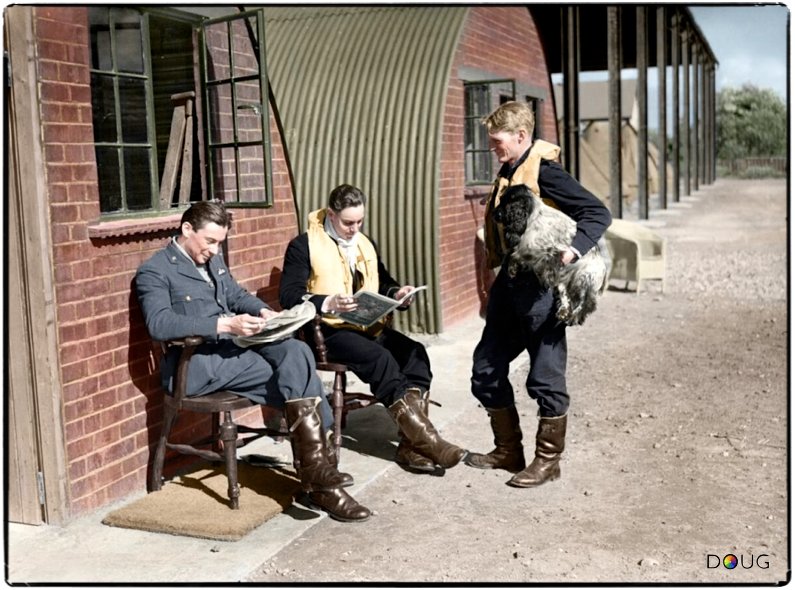
Pilots of No. 19 Squadron RAF relax between sorties outside their
crew room at Manor Farm, Fowlmere, Cambridgeshire. They are (left to right),
Pilot Officer W Cunningham, Sub-Lieutenant A G Blake of the Fleet Air Arm
(nicknamed "The Admiral") and Flying Officer F N Brinsden (New Zealander),
with a Cocker Spaniel. September 1940.
In that month Blake was credited with six and a half kills; 5 Bf
109s, 2 of which were destroyed on one sortie on 17th September and 2 on
27th September. He also downed a He111, shared a second and was credited
with a possible Bf110.
Sadly, he was to become No 19 Squadron’s last casualty of the battle.
He was shot down and killed whilst flying Spitfire Mk IIa P7423 QV-Y in
the early evening of 29th October 1940 over Chelmsford, Essex. He was just
23 years old.
© IWM (CH 1459)
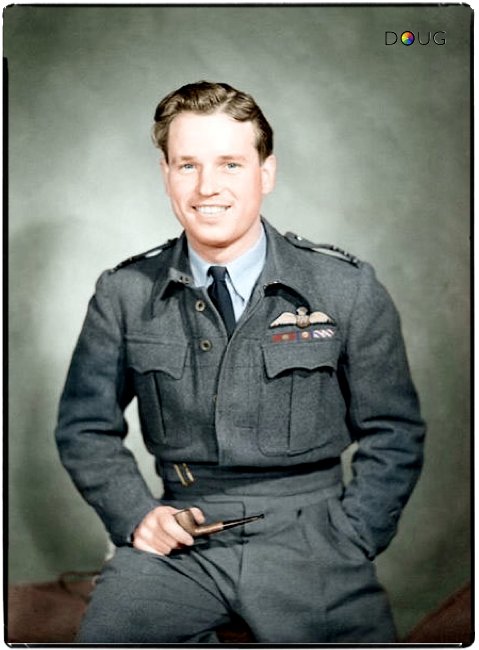
Wing Commander Guy Penrose Gibson VC. DSO and bar DFC and bar.
(12 August 1918 - 19 September 1944)
He was the first CO of the Royal Air Force's 617 Squadron, which
he led in the 'Dam Busters' raid (Operation Chastise) in 1943, resulting
in the destruction of two large dams in the Ruhr area, for which he was
awarded the Victoria Cross.
On September 19th 1944, Gibson and his navigator, Squadron Leader
Jim Warwick, departed RAF Hemswell in a De Havilland Mosquito Mk.XX to
serve as the Pathfinder Master Bomber for a large raid on Rheydt and Mönchengladbach.
Executing the mission and ordering the bombers home, Gibson was not heard
from again. The remains of his Mosquito were located near Steenbergen,
Netherlands.
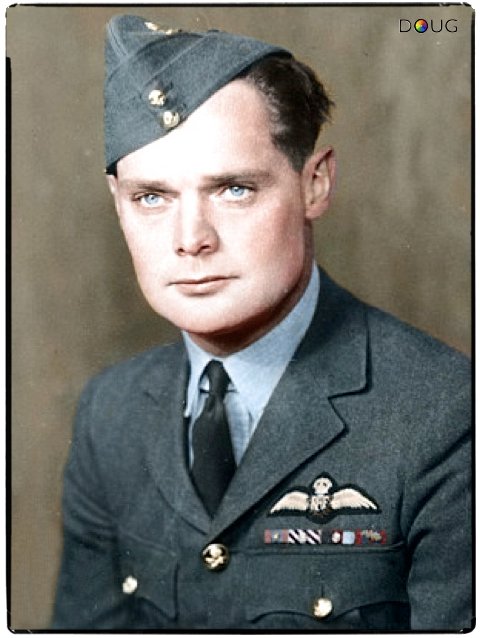
Douglas Bader (21 February 1910 – 5 September 1982)
He joined the RAF in 1928 but in December 1931, while attempting
some aerobatics, he crashed and lost both his legs and was retired against
his will on medical grounds. After the outbreak of the Second World War
in 1939, however, Bader returned to the RAF and was accepted as a pilot.
During the Second World War, he was credited with 20 aerial victories,
four shared victories, six probables, one shared probable and 11 enemy
aircraft damaged.
On the 9th August 1941 he was shot down during a dog-fight over
German-occupied France, bailed out and was captured.
Despite his disability, Bader made a number of escape attempts and
was eventually sent to the POW camp at Colditz Castle. He remained there
until April 1945 when the camp was liberated by the First United States
Army.
On 21 July 1946, Bader retired from the RAF with the rank of Group
Captain.
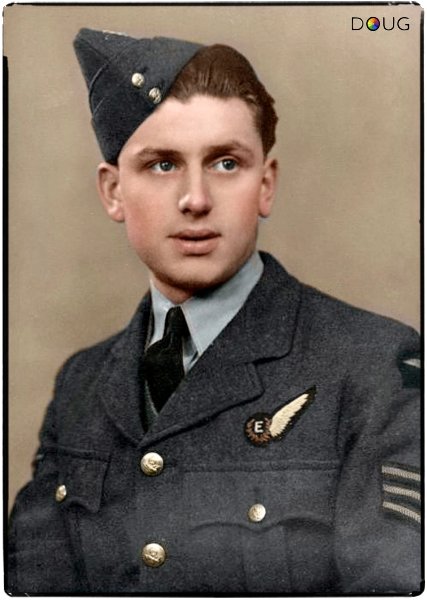
Flight Sergeant Jack Forrest (aged 21), Flight Engineer, Avro Lancaster
of Squadron 619 RAF. His Lancaster LL783 PG-C ('Cinders of the Clouds')
was shot down on a raid over Caen on D-Day 6th June '44 and only he and
the bomb aimer Reg De-Viell survived. They were held as POWs in Stalag
Luft 7 in Poland until making the "Long March" to Germany in 1945. (the
photo and facts were kindly supplied by courtesy of his daughter Ann Forrest)
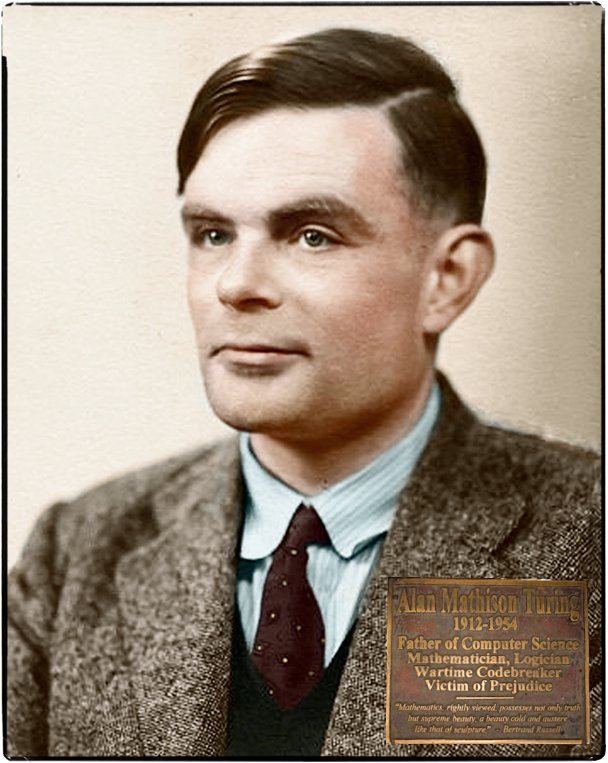
Alan Mathison Turing: 'The Enigma'
Alan Turing was born on 23 June, 1912, in London. His father was
in the Indian Civil Service and Turing's parents lived in India until his
father's retirement in 1926. Turing and his brother stayed with friends
and relatives in England. Turing studied mathematics at Cambridge University,
and subsequently taught there, working in the burgeoning world of quantum
mechanics. It was at Cambridge that he developed the proof which states
that automatic computation cannot solve all mathematical problems. This
concept, also known as the Turing machine, is considered the basis for
the modern theory of computation.
In 1936, Turing went to Princeton University in America, returning
to England in 1938. He began to work secretly part-time for the British
cryptanalytic department, the Government Code and Cypher School. On the
outbreak of war he took up full-time work at its headquarters, Bletchley
Park.
Here he played a vital role in deciphering the messages encrypted
by the German Enigma machine, which provided vital intelligence for the
Allies. He took the lead in a team that designed a machine known as a bombe
that successfully decoded German messages. He became a well-known and rather
eccentric figure at Bletchley.
After the war, Turing turned his thoughts to the development of
a machine that would logically process information. He worked first for
the National Physical Laboratory (1945-1948). His plans were dismissed
by his colleagues and the lab lost out on being the first to design a digital
computer. It is thought that Turing's blueprint would have secured them
the honour, as his machine was capable of computation speeds higher than
the others. In 1949, he went to Manchester University where he directed
the computing laboratory and developed a body of work that helped to form
the basis for the field of artificial intelligence. In 1951 he was elected
a fellow of the Royal Society.
In 1952, Turing was arrested and tried for homosexuality, then a
criminal offence. To avoid prison, he accepted injections of oestrogen
for a year, which were intended to neutralise his libido. In that era,
homosexuals were considered a security risk as they were open to blackmail.
Turing's security clearance was withdrawn, meaning he could no longer work
for GCHQ, the post-war successor to Bletchley Park.
He committed suicide on 7 June, 1954.
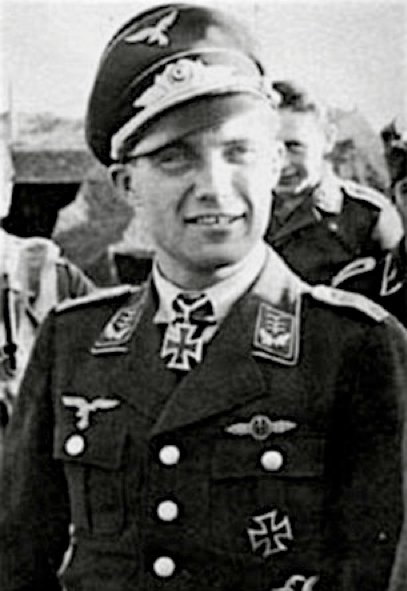
Franz von Werra was born on 13 July 1914 at Leuk in the Berner Oberland
region of Switzerland.
Von Werra was appointed Adjutant on the staff of II./JG 3, on its
formation at Zerbst on 1 February 1940.
A brief History of the Pilot and the Plane
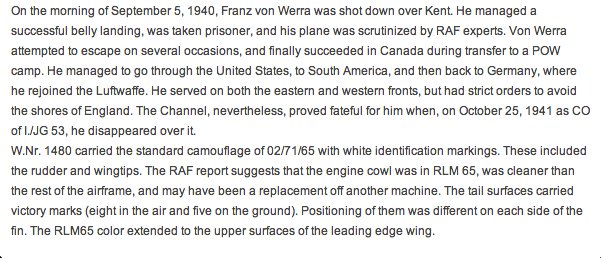
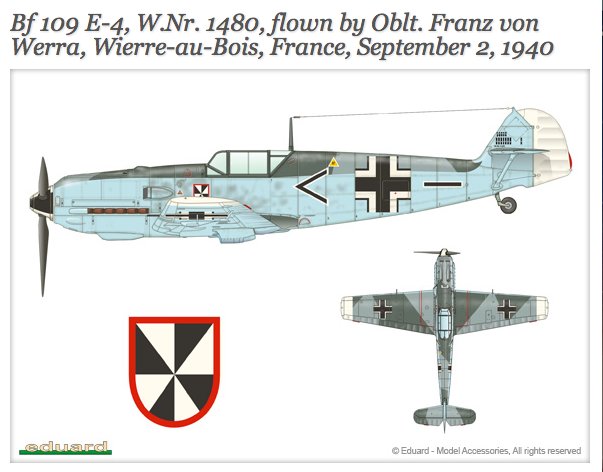
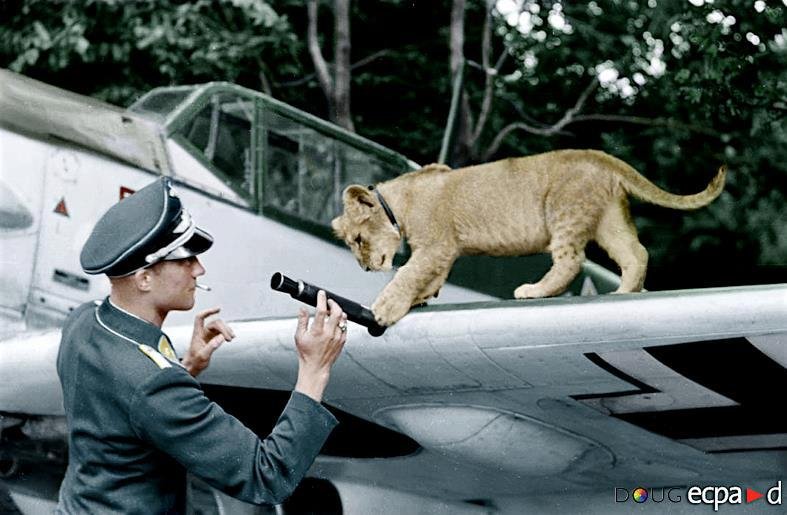
Mascot
Le lieutenant Franz von Werra -3e escadrille (II./Jagdgeschwader
3) and the group's mascot: a baby lion.

'Simba' the squadron's pet lion cub
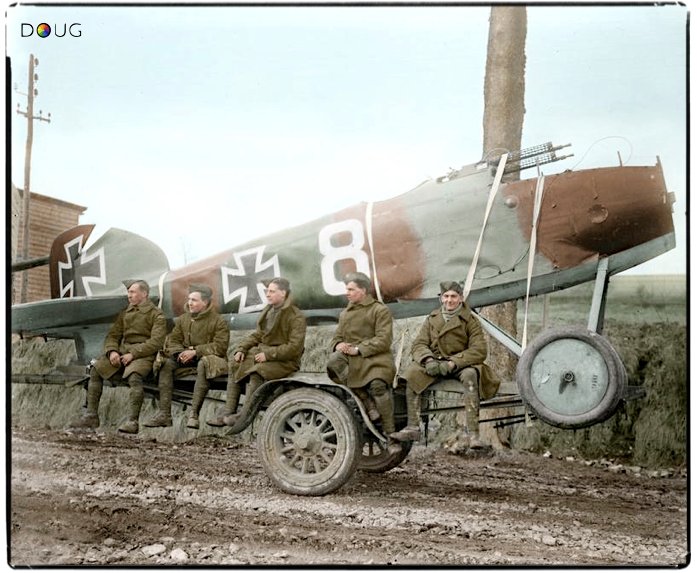
A captured Albatros D.II previously flown by Lt. Max Böhme
of Jagdstaffel Nº.5,
it was forced down over allied lines and is seen here being transported
to a British aviation depot
near to the location of Auxi-le-Château, France. Lt.Böhme
survived and became a POW.
The engagement occurred on the 4th March 1917 and the 'claim'
was made by both an FE 2b crew and a DH 2 pilot Lt. Arthur Pearson
who would be shot down and killed five days later by the 'Red Baron'
Manfred von Richthofen.
IWM (Q 4932)
(It was later repainted in French colours and Tested at Vélizy-Villacoublay,
France)
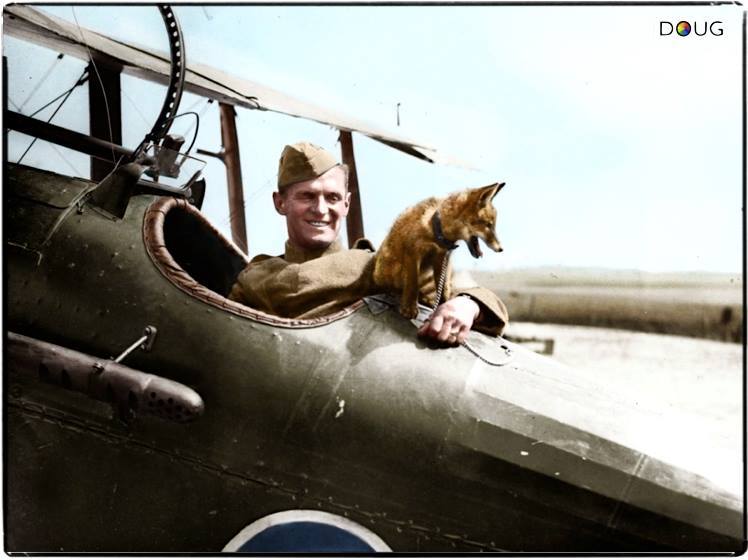
Royal Aircraft Factory S.E.5
and an unknown RFC personnel with the No. 32 Squadron pet fox,
at Humieres Aerodrome, St Pol,
France, 5 May 1918. (National Library of Scotland)
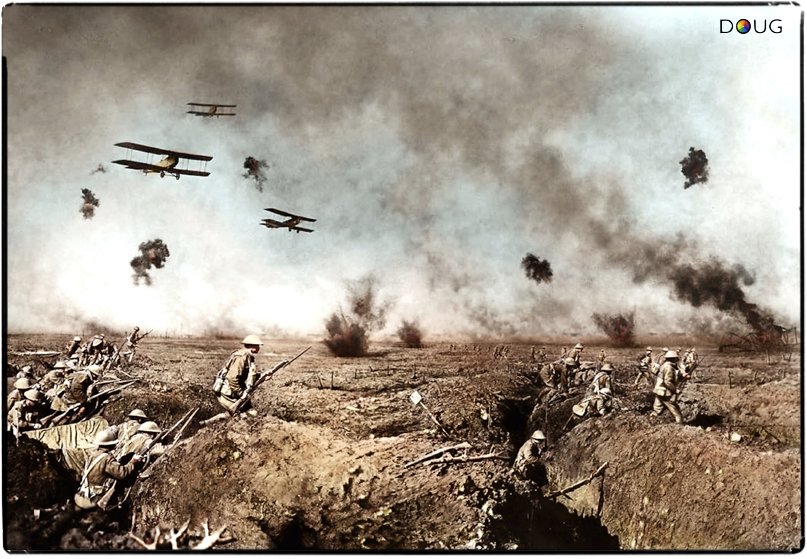
'The Raid' 1918 by photographer
Frank Hurley (AWM) from British History
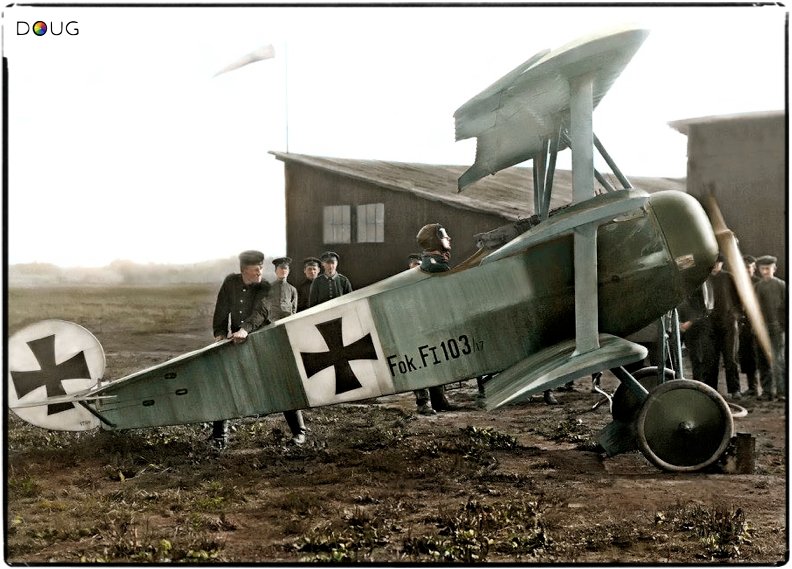
Lieutenant Werner Voss, Staffelführer
of Jasta 10 in his Fokker F.1, September 1917. (KIA 23/9/17 aged 20)
Voss achieved 48 victories in
just over ten short months. It took von Richthofen, the Red Baron two years
to achieve his 80 victories.
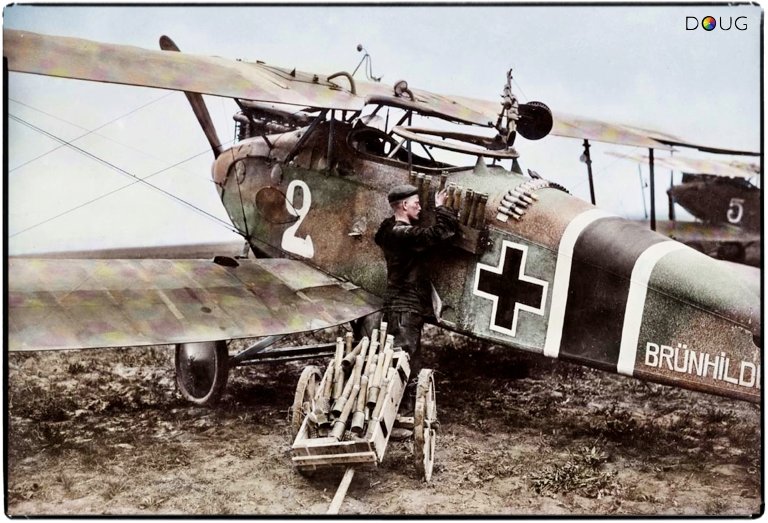
An armourer loading grenades
and signal flares onto a Halberstadt CL.II "Brünhilde"
of Schlasta 27b at Boucheneuil
airfield Belgium. April 1918
![]()
BACK TO OUR MONTHLY MILITARY WEBZINE
CONTENTS PAGE
As
You Were . . .
![]()
|
As You Were . . . Tribute Webzines |
Hillman WWII Tributes www.hillmanweb.com/war |
www.hillmanweb.com/rcaf RCN HMCS PRINCE ROBERT www.hillmanweb.com/rcn |
Ex-Air Gunners Association Magazines |
 .
.